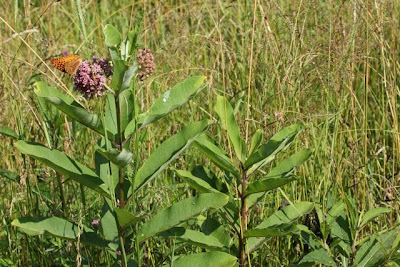Today I just want to share some photos that I have been having a wonderful time working on. I started following the progress of MILKWEEDS a month ago, now that George Ella has changed the letter M in the alphabet book we are working on. "M" now reads as "milkweed in the meadow."
These plants make some large changes during the growing season! The large blooms are replaced by large seed pods -- which I look forward to photographing once they start to open. I thought the white tails on those seeds were the reason for the plant's name, but no, it comes instead from the white fluid (sap) that oozes out of the stem system. (Is it obvious I managed to get through high school AND college without ever studying biology? I often have cause to regret having missed that course.)
I am also a big fan of milkweed, though, because of the esssential role it plays in nourishing monarch butterflies. Here are two links about that part of the story: click this or this.
This first photo is just an overview of "milkweed in the meadow." There's a bit too much bright sun in this photo for me to be able to use it, plus it isn't as strong as it could be in the design department... What it does is give a context.
 |
| These other milkweeds are located on the edge of our driveway. The following two photos show the stalks, from each location. To me, these don't look like the same variety of milkweed. |
 |
| Recently the blossoms have given way to these large seed pods. Last week I found a visiting orange "milkweed bug" on each stalk. |
 |
| Then, early this morning, I found this wonderful spider and its web between two of the stalks |
 |
| and this leaf, about to fall. |
My favorite photo so far is this early one, with its butterfly visitor. I have made a note card from this photo, calling it "milkweed mama." I like how everything works together, photographically, even the shadows on the green leaf.
A photography friend, Betty Hall, who lives in Lexington, KY, shares her butterfly fascination and her special garden on her blog, called Celebrating the Ordinary. I recommend it highly. I put the link here for the post where she talks about not seeing any Monarchs this year before July 1, for the first time in 7 years.
I am also in the middle of reading Barbara Kingsolver's latest book, Flight Behavior. Of course I don't need all this info in order to make a good photo, but I can't help caring and being curious about how these pieces of our world work together. I thank people like Betty and Barbara for making art out of their passions.































